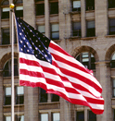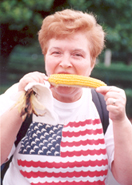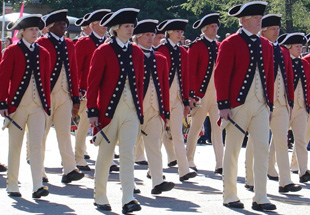The Fourth of July 2005
On this day in 1776, the Declaration of Independence was approved by
the Continental Congress, starting the 13 colonies on the road to freedom
as a sovereign nation. As always, this most American of holidays will
be marked by parades, fireworks and backyard barbecues across the country. |
|
296.5 million
Projected number of U.S. residents on this July 4th. Back in July 1776,
there were about 2.5 million people living in the colonies. (2005 population
from unpublished data; 1776 population from Historical Statistics
of the United States: Colonial Times to 1970.)
|
Fireworks
$164.2 million
The value of fireworks
imported from China in 2004, representing the bulk of all U.S. fireworks
imports ($172.5 million). U.S. exports of fireworks, by comparison, came
to just $14.3 million in 2004, with Japan purchasing more than any other
country ($4.7 million).
$17.3 million
The value
of U.S. manufacturers’ shipments of fireworks in 2002 [PDF]. |
Patriotic-Sounding Places
30
Number of places nationwide with “liberty” in their name. The
most populous one is Liberty, Mo. (27,982). Iowa, with four, has more of
these places than any other state: Libertyville, New Liberty, North Liberty
and West Liberty.
- Eleven places have “independence” in their name. The
most populous of these is Independence, Mo., with 112,079 residents.
- Five places adopted the name “freedom.” Freedom, Calif.,
with 6,000 residents, has the largest population among these.
- There is one place named “patriot” — Patriot, Ind.,
with a population of 196.
- And what could be more fitting than spending the Fourth of July in
a
place called “America”? There are five such places in
the country, with the most populous being American
Fork, Utah, population 22,876.
|
 Flags
$5.2 million
The dollar value of U.S.
imports of American flags in 2004; the vast majority of this amount
($4.8 million) was for U.S. flags made in China.
$851,000
Dollar value of U.S.
flag exports in 2004. Mexico was the leading customer, purchasing
$312,000 worth.
$349 million
Annual dollar value of shipments of fabricated flags, banners and similar
emblems by the nation’s manufacturers, according to the latest published
Economic
Census (2002) data [PDF]. |
The Fourth of July Cookout
150 million
Number of hot dogs (all varieties) expected to be consumed by Americans
on the Fourth. (That’s one frankfurter for every two people.) There’s
about a 1-in-4 chance that the hot dogs made of pork originated in Iowa,
as the Hawkeye State had a total inventory of 16.2 million hogs and pigs
on March 1, 2005. This represents more than one-fourth of the nation’s
total. (Data on hot dog consumption courtesy of the National Hot Dog and
Sausage Council.) Data on hogs and pigs at <http://www.usda.gov/nass/>.
7.3 billion pounds
Total production of cattle and calves
in Texas in 2004. Chances are that the beef hot dogs, steaks and burgers
on your backyard grill came from the Lone Star State, which accounted
for over one-sixth of the nation’s total production.
6
Number of states in which the revenue
from chicken broilers was $1 billion or greater in 2004. There is
a good chance that one of these states — Georgia, Arkansas, Alabama,
North Carolina, Mississippi or Texas — is the source of your barbecued
chicken.
Better than 50-50
The odds that the beans in your
side dish of baked beans came from North Dakota, Michigan or Nebraska,
which produced 58 percent of the nation’s dry, edible beans in 2004.
Another popular July 4th side dish is corn
on the cob. California and Florida together accounted for about 45
percent of the value of sweet corn produced nationally in 2004.
One-half
Amount of the nation’s spuds
produced in Idaho or Washington in 2004. Potato salad and potato chips
are also popular food items at July 4th barbecues.
Nearly 69 million
Number of Americans who said they have taken
part in a barbecue [PDF] during the previous year. It’s probably
safe to assume a lot of these events took place on Independence Day. |
Coming to America
34 million
The number of foreign-born
residents in the United States in 2004; they accounted for 12 percent of
the nation’s total population. Another 30 million Americans were “second-
generation,” meaning that at least one of their parents was born abroad.
53%
Percentage of the nation’s foreign-born
population born in Latin America, as of 2004.
706,000
Number of immigrants
granted legal permanent residence in the United States during fiscal
year 2003. One in four settled in California, and 1-in-10 in the New York
metro area.
463,000
Number of people
who became naturalized U.S. citizens during fiscal 2003 [PDF]. Mexico
contributed the highest number of naturalized citizens in 2003 (56,100),
followed by India (29,800), the Philippines (29,100), Vietnam (26,000)
and China (24,000). |
- Martin Luther King, Jr. Day (Jan. 17)/
African-American History Month (February)
- Valentine's Day (Feb. 14)
- Women's History Month (March)
- Irish-American Heritage Month (March)/
St. Patrick's Day (March 17)
- Asian pacific American Heritage Month (May)
- Older Americans Month (May)
- Mother's Day (May 8)
- Father's Day (June 19)
- The Fourth of July (July 4)
- Anniversary of Americans with Disabilities Act
(July 26)
|
- Back to School (August)
- Labor Day (Sept. 5)
- Grandparents Day (Sept. 11)
- Hispanic Heritage Month (Sept. 15-
Oct. 15)
- Halloween (Oct. 31)
- American Indian/Alaska Native Heritage
Month (November)
- Veterans Day (Nov. 11)
- Thanksgiving Day (Nov. 24)
- The Holiday Season (December)
|
Individual source links for each statement
herein may be accessed on the Internet at
<http://www.census.gov/Press-Release/www/releases/archives/facts_for_features_special_editions/004772.html>.
The photos
herein may be downloaded and are available free for your use in all
print and broadcast products.
Please credit the U.S. Census Bureau. For product information, call (301)
763-3011 or e-mail <pio.broadcast.services@census.gov>.
Editor’s note: Some of the preceding data were
collected in surveys and, therefore, are subject to sampling error. Questions
or comments should be directed to the Census Bureau’s Public Information
Office at (301) 763-3030; fax (301) 457-3670; or e-mail <pio@census.gov>.
|






